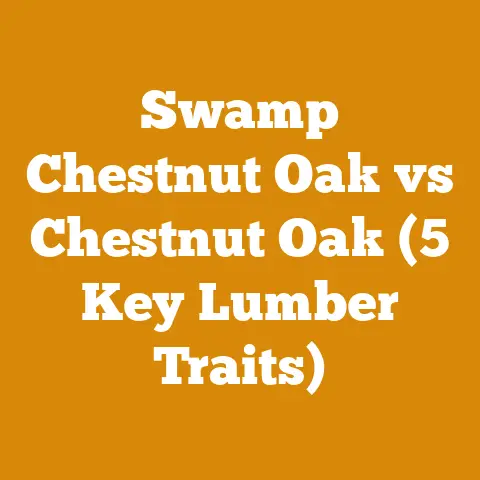Corn Wood Pellets vs Firewood (5 Heat Output Facts)
Ever wondered if those neat little corn wood pellets could actually give old-fashioned firewood a run for its money? It’s a question that’s been burning in my mind for a while, especially after a particularly brutal winter where keeping the home fires burning became a Herculean task. As someone who’s spent years wrestling with chainsaws, splitting mauls, and the occasional stubborn log, I’ve developed a healthy respect for the science – and the sheer effort – behind heating with wood. But times are changing, and corn wood pellets are making a serious play for a slice of the home heating pie.
So, let’s dive deep into the heart of the matter: corn wood pellets vs. firewood. We’re not just talking about which one smells nicer (though that’s a factor!), but about the nitty-gritty of heat output, cost, convenience, and environmental impact. I’ll be sharing some hard-won insights from my own experiences, along with data and research, to help you make an informed decision. Get ready to stoke your knowledge and see which fuel truly comes out on top.
Corn Wood Pellets vs. Firewood: 5 Heat Output Facts
1. BTU Battle: Unveiling the Energy Potential
The most fundamental question when comparing heating sources is, “How much heat do I get for my buck?” This is where the concept of British Thermal Units (BTUs) comes into play. A BTU is the amount of energy needed to raise the temperature of one pound of water by one degree Fahrenheit. The higher the BTU rating, the more heat the fuel produces.
-
Firewood: The BTU content of firewood is highly variable, depending primarily on the wood species and its moisture content. Hardwoods like oak, maple, and birch generally pack more punch than softwoods like pine or fir. A cord of seasoned (dried) oak, for instance, can deliver around 24-30 million BTUs. However, unseasoned or “green” wood can lose up to half its potential heat output due to the energy required to evaporate the water.
-
Corn Wood Pellets: Corn wood pellets offer a more consistent BTU output. Typically, they clock in at around 8,000-9,000 BTUs per pound. A ton (2,000 lbs) of corn wood pellets, therefore, delivers approximately 16-18 million BTUs.
Data Point: According to the Pellet Fuels Institute, premium wood pellets generally have a heating value of around 8,500 BTUs per pound. This is a reliable benchmark for comparing against different firewood types.
My Experience: I recall one particularly wet autumn where I struggled to get my firewood properly seasoned. The result? A lot of hissing and sputtering in the stove, and a distinctly chilly living room. That experience drove home the importance of moisture content and its impact on heat output.
Insight: While a cord of seasoned hardwood can potentially deliver more BTUs than a ton of corn wood pellets, the variability of firewood makes corn wood pellets a more predictable and consistent heat source. The key is ensuring your firewood is properly seasoned.
2. Efficiency Matters: From Fuel to Usable Heat
BTUs are just the starting point. The real test is how efficiently a fuel converts its energy potential into usable heat in your home. This is where the type of appliance you use – a wood stove, a pellet stove, or a fireplace – becomes critical.
-
Firewood Stoves/Fireplaces: Traditional wood stoves and fireplaces can have relatively low efficiency ratings. Open fireplaces, in particular, are notoriously inefficient, with much of the heat escaping up the chimney. Modern, EPA-certified wood stoves are significantly more efficient, often achieving ratings of 70-80%. However, even with these improved stoves, factors like the draft, the type of wood, and how often you reload the stove can affect efficiency.
-
Corn Wood Pellet Stoves: Corn wood pellet stoves are designed for optimal efficiency. They typically boast efficiency ratings of 75-90%. This is because they control the fuel feed and airflow precisely, ensuring a more complete and consistent burn. Many pellet stoves also have features like automatic ignition and thermostat control, further enhancing efficiency.
Data Point: The EPA maintains a list of certified wood stoves with their efficiency ratings. Checking this list can help you choose a stove that maximizes heat output from your firewood.
My Experience: I once experimented with an older, non-EPA certified wood stove. While it looked charming, it was a heat hog, sucking up wood and sending most of the warmth straight up the chimney. Upgrading to a modern, efficient stove made a world of difference.
Insight: Corn wood pellet stoves generally offer higher efficiency than traditional wood stoves or fireplaces, meaning you get more usable heat from the same amount of fuel. This translates to lower fuel consumption and potentially lower heating costs over time.
3. Moisture Content: The Silent Heat Thief
As I hinted at earlier, moisture content is the enemy of efficient wood burning. Water in firewood absorbs heat as it evaporates, reducing the amount of energy available to warm your home.
-
Firewood: Ideally, firewood should be seasoned to a moisture content of 20% or less. This typically takes 6-12 months of air-drying, depending on the wood species, climate, and how the wood is stacked. Green wood can have a moisture content of 50% or higher, making it difficult to light and significantly reducing its heat output.
-
Corn Wood Pellets: Corn wood pellets have a very low moisture content, typically around 5-10%. This is one of the key reasons for their high efficiency and consistent heat output. Because they are manufactured in a controlled environment, the moisture content is carefully regulated.
Data Point: A study by the University of Maine found that burning unseasoned wood can reduce heat output by as much as 50% compared to seasoned wood.
My Experience: I invested in a moisture meter a few years ago, and it’s been a game-changer. Now, I can accurately assess the moisture content of my firewood before burning it, ensuring I’m getting the most heat for my effort.
Insight: The low moisture content of corn wood pellets provides a significant advantage in terms of heat output. You can be confident that you’re getting consistent and efficient heat every time you burn them. Firewood, on the other hand, requires careful seasoning and monitoring to achieve optimal heat output.
Formula: You can estimate the heat loss due to moisture content using the following formula:
Heat Loss (%) = (Moisture Content (%) – 20%) * 2
This formula provides a rough estimate of the percentage of heat lost due to moisture.
4. Ash Production: A Measure of Combustion
Ash is the non-combustible residue left behind after burning fuel. Lower ash production generally indicates more complete combustion and higher efficiency.
-
Firewood: Firewood typically produces a moderate amount of ash, depending on the wood species and how completely it burns. Hardwoods tend to produce more ash than softwoods. The ash needs to be removed periodically from the stove or fireplace.
-
Corn Wood Pellets: Corn wood pellets produce very little ash, typically less than 1% by weight. This is due to their high density and consistent composition. The low ash content means less frequent cleaning of the stove.
Data Point: The Pellet Fuels Institute standard requires that premium wood pellets have an ash content of no more than 1%.
My Experience: I used to dread cleaning out my wood stove, especially after burning a lot of softwood. The ash was messy and time-consuming to remove. Switching to corn wood pellets significantly reduced the amount of ash I had to deal with.
Insight: The low ash production of corn wood pellets is a significant advantage in terms of convenience and maintenance. It reduces the frequency of cleaning and makes the whole heating process less messy.
5. Flame Characteristics: The Subjective Side of Heat
While BTUs and efficiency are important, the visual and sensory aspects of a fire also contribute to the overall heating experience.
-
Firewood: Firewood produces a lively, flickering flame that many people find aesthetically pleasing. The crackling and popping sounds of burning wood add to the ambiance.
-
Corn Wood Pellets: Corn wood pellets typically produce a smaller, more consistent flame. While some people may find this less visually appealing than a wood fire, others appreciate the steady, predictable heat.
My Experience: There’s something undeniably comforting about watching a roaring wood fire on a cold winter evening. The smell of burning wood, the dancing flames – it’s a primal experience that’s hard to replicate. However, I’ve also come to appreciate the consistent, hassle-free heat provided by corn wood pellets.
Insight: The flame characteristics are largely a matter of personal preference. If you prioritize the visual and sensory aspects of a fire, firewood may be a better choice. If you prefer consistent, predictable heat and low maintenance, corn wood pellets may be more appealing.
Understanding the Cost Equation: A Deeper Dive
Now that we’ve explored the heat output characteristics of corn wood pellets and firewood, let’s tackle the complex issue of cost. Determining the true cost of heating with either fuel involves more than just comparing the price per cord or per ton. We need to consider all the associated expenses, from acquisition to maintenance.
Timber Purchase and Harvesting Costs (Firewood)
If you plan to harvest your own firewood, you need to factor in the following costs:
-
Permits: In many areas, you’ll need a permit to harvest firewood from public lands. The cost of these permits can vary widely, depending on the location and the amount of wood you’re allowed to take. I’ve seen permits range from \$20 to \$100 per cord.
-
Equipment: You’ll need a chainsaw, splitting maul, wedges, and other tools. A decent chainsaw can cost anywhere from \$200 to \$500. A good splitting maul will set you back around \$50 to \$100. Don’t forget safety gear like a helmet, eye protection, and gloves. These can add another \$100 to \$200 to your initial investment.
-
Fuel and Maintenance: Chainsaws require fuel and oil, and they need periodic maintenance like sharpening and tune-ups. Expect to spend around \$50 to \$100 per year on these expenses.
-
Transportation: You’ll need a truck or trailer to haul the firewood home. Factor in the cost of fuel and any wear and tear on your vehicle.
-
Labor: Don’t underestimate the physical labor involved in harvesting firewood. It’s hard work! If you value your time, you might want to consider the opportunity cost of spending hours in the woods.
Data Point: According to the U.S. Forest Service, the average cost of a firewood permit on national forests is around \$5 per cord. However, this can vary significantly depending on the region and the demand for firewood.
My Experience: I once spent an entire weekend felling trees and splitting wood, only to realize that I had underestimated the amount of time and effort involved. By the end of the weekend, I was exhausted and my back was aching. I learned a valuable lesson about the true cost of “free” firewood.
Insight: Harvesting your own firewood can be a cost-effective option, but it requires a significant investment of time, effort, and equipment. Be sure to factor in all the associated costs before deciding to go this route.
Firewood Purchase Costs
If you choose to buy firewood, the cost will depend on the wood species, the quantity, and the supplier.
-
Price per Cord: The price of firewood typically ranges from \$150 to \$400 per cord, depending on the factors mentioned above. Hardwoods like oak and maple are generally more expensive than softwoods like pine and fir. Seasoned wood will also cost more than green wood.
-
Delivery Fees: Many suppliers charge a delivery fee, especially for smaller orders. This fee can range from \$25 to \$75, depending on the distance and the supplier.
-
Stacking Fees: Some suppliers will also stack the firewood for an additional fee. This can be a convenient option if you don’t have the time or energy to do it yourself.
Data Point: According to the National Firewood Association, the average price of a cord of seasoned hardwood in the United States is around \$250. However, this can vary significantly depending on the region and the time of year.
My Experience: I’ve found that it pays to shop around for firewood. Prices can vary significantly from supplier to supplier. It’s also important to ask about the wood species, the moisture content, and the size of the cord. A “cord” should be 128 cubic feet, but some unscrupulous suppliers may try to sell you less.
Insight: Buying firewood is a more convenient option than harvesting it yourself, but it can also be more expensive. Be sure to compare prices from different suppliers and ask about any hidden fees.
Corn Wood Pellet Costs
The cost of corn wood pellets depends on the quality, the quantity, and the supplier.
-
Price per Ton: The price of corn wood pellets typically ranges from \$200 to \$350 per ton, depending on the factors mentioned above. Premium pellets will cost more than standard pellets.
-
Delivery Fees: As with firewood, many suppliers charge a delivery fee for corn wood pellets. This fee can range from \$50 to \$150, depending on the distance and the supplier.
-
Storage: You’ll need a dry place to store your corn wood pellets. If you don’t have a garage or shed, you may need to invest in a storage container.
Data Point: According to the Pellet Fuels Institute, the average price of a ton of premium wood pellets in the United States is around \$250. However, this can vary depending on the region and the time of year.
My Experience: I’ve found that buying corn wood pellets in bulk can save you money. Many suppliers offer discounts for large orders. It’s also important to check the pellets for quality. Look for pellets that are uniform in size and shape, and that have a low dust content.
Insight: Corn wood pellets offer a consistent and convenient heating option, but they can be more expensive than firewood in some areas. Be sure to compare prices from different suppliers and consider buying in bulk to save money.
Appliance Costs: Stove and Chimney Considerations
The cost of heating with either firewood or corn wood pellets also depends on the type of appliance you use.
-
Wood Stove/Fireplace Costs: A new wood stove can cost anywhere from \$1,000 to \$5,000, depending on the size, the efficiency, and the features. Installation costs can add another \$500 to \$2,000, depending on the complexity of the installation and whether you need to install a chimney.
-
Corn Wood Pellet Stove Costs: A new corn wood pellet stove can cost anywhere from \$1,500 to \$4,000, depending on the size, the features, and the brand. Installation costs are typically lower than for wood stoves, ranging from \$300 to \$1,000.
Data Point: According to the EPA, a new EPA-certified wood stove can save you up to 30% on your heating costs compared to an older, non-certified stove.
My Experience: I upgraded my old wood stove to a new EPA-certified model a few years ago, and it was one of the best investments I’ve ever made. Not only did it save me money on firewood, but it also reduced the amount of smoke and pollution coming from my chimney.
Insight: The type of appliance you use can have a significant impact on the overall cost of heating with either firewood or corn wood pellets. Investing in an efficient stove can save you money in the long run.
Maintenance and Repair Costs
Both wood stoves and corn wood pellet stoves require periodic maintenance and repairs.
-
Wood Stove Maintenance: Wood stoves need to be cleaned regularly to remove creosote buildup. Creosote is a flammable substance that can accumulate in the chimney and cause a fire. You should also have your chimney inspected and cleaned by a professional chimney sweep at least once a year. The cost of a chimney sweep can range from \$100 to \$300.
-
Corn Wood Pellet Stove Maintenance: Corn wood pellet stoves require less maintenance than wood stoves, but they still need to be cleaned regularly. You should clean the burn pot and the heat exchanger at least once a week. You may also need to replace the igniter or other parts from time to time.
Data Point: The National Fire Protection Association (NFPA) recommends that chimneys be inspected and cleaned at least once a year.
My Experience: I learned the hard way about the importance of regular chimney cleaning. I had a chimney fire a few years ago, and it was a terrifying experience. Fortunately, the fire department was able to put it out quickly, but it could have been much worse. Now, I make sure to have my chimney inspected and cleaned every year.
Insight: Regular maintenance is essential for both wood stoves and corn wood pellet stoves. It can prevent costly repairs and ensure that your stove operates safely and efficiently.
Cost Optimization Strategies: Saving Money on Heating
Now that we’ve covered all the cost factors, let’s explore some strategies for optimizing your heating costs.
Firewood Cost Optimization
- Buy in Bulk: Buying firewood in bulk can save you money. Many suppliers offer discounts for large orders.
- Season Your Own Wood: Seasoning your own firewood can save you money, especially if you have access to free or low-cost wood.
- Shop Around: Prices can vary significantly from supplier to supplier. Be sure to compare prices before buying.
- Negotiate: Don’t be afraid to negotiate with suppliers, especially if you’re buying a large quantity of wood.
- Burn Efficiently: Burn your firewood efficiently by using a modern, EPA-certified stove and by properly seasoning the wood.
Corn Wood Pellet Cost Optimization
- Buy in Bulk: Buying corn wood pellets in bulk can save you money. Many suppliers offer discounts for large orders.
- Shop Around: Prices can vary significantly from supplier to supplier. Be sure to compare prices before buying.
- Negotiate: Don’t be afraid to negotiate with suppliers, especially if you’re buying a large quantity of pellets.
- Burn Efficiently: Burn your pellets efficiently by using a modern, high-efficiency stove and by adjusting the settings to match your heating needs.
- Consider Alternative Fuels: In some areas, you may be able to find cheaper alternatives to corn wood pellets, such as switchgrass pellets or sunflower seed pellets.
General Heating Cost Optimization
- Insulate Your Home: Proper insulation can significantly reduce your heating costs.
- Seal Drafts: Seal any drafts around windows and doors to prevent heat loss.
- Use a Programmable Thermostat: A programmable thermostat can help you save energy by automatically adjusting the temperature when you’re away from home.
- Lower Your Thermostat: Lowering your thermostat by a few degrees can save you a significant amount of money on your heating bill.
- Use Supplemental Heating: Consider using supplemental heating sources, such as space heaters or electric blankets, to heat specific areas of your home.
Case Studies: Real-World Cost Comparisons
To illustrate the cost differences between corn wood pellets and firewood, let’s look at a couple of hypothetical case studies.
Case Study 1: Rural Homeowner in Maine
- Home: 1,500 square foot home in rural Maine
- Heating Needs: Requires 6 cords of firewood or 6 tons of corn wood pellets per year
- Firewood Costs: \$200 per cord (seasoned hardwood), \$50 delivery fee per order
- Corn Wood Pellet Costs: \$250 per ton, \$75 delivery fee per order
Firewood Costs:
- 6 cords x \$200/cord = \$1,200
- 6 cords / 2 cords per delivery = 3 deliveries
- 3 deliveries x \$50/delivery = \$150
- Total Firewood Costs = \$1,200 + \$150 = \$1,350
Corn Wood Pellet Costs:
- 6 tons x \$250/ton = \$1,500
- 6 tons / 2 tons per delivery = 3 deliveries
- 3 deliveries x \$75/delivery = \$225
- Total Corn Wood Pellet Costs = \$1,500 + \$225 = \$1,725
Analysis: In this case, firewood is the cheaper option, saving the homeowner \$375 per year. However, this doesn’t factor in the time and effort required to handle firewood.
Case Study 2: Suburban Homeowner in Colorado
- Home: 2,000 square foot home in suburban Colorado
- Heating Needs: Requires 4 cords of firewood or 4 tons of corn wood pellets per year
- Firewood Costs: \$350 per cord (seasoned hardwood), \$75 delivery fee per order
- Corn Wood Pellet Costs: \$200 per ton, \$50 delivery fee per order
Firewood Costs:
- 4 cords x \$350/cord = \$1,400
- 4 cords / 2 cords per delivery = 2 deliveries
- 2 deliveries x \$75/delivery = \$150
- Total Firewood Costs = \$1,400 + \$150 = \$1,550
Corn Wood Pellet Costs:
- 4 tons x \$200/ton = \$800
- 4 tons / 2 tons per delivery = 2 deliveries
- 2 deliveries x \$50/delivery = \$100
- Total Corn Wood Pellet Costs = \$800 + \$100 = \$900
Analysis: In this case, corn wood pellets are the cheaper option, saving the homeowner \$650 per year. This is due to the lower price of pellets in this region.
Important Note: These are just hypothetical examples. The actual costs will vary depending on your location, your heating needs, and the prices in your area.
Actionable Takeaways and Next Steps
So, what’s the bottom line? Corn wood pellets offer consistent heat output, high efficiency, and low maintenance. Firewood provides a classic, visually appealing fire, but requires more effort and attention. Choosing between the two depends on your priorities and circumstances.
Here are some actionable steps to take:
- Assess Your Heating Needs: Determine how much heat you need to keep your home comfortable.
- Research Local Prices: Compare the prices of firewood and corn wood pellets in your area.
- Consider Your Lifestyle: Think about how much time and effort you’re willing to invest in heating your home.
- Evaluate Your Appliance: Choose an efficient stove that is appropriate for your heating needs and your budget.
- Plan Your Budget: Create a detailed budget that includes all the costs associated with heating with either firewood or corn wood pellets.
Ultimately, the best choice for you will depend on your individual needs and preferences. By carefully considering all the factors involved, you can make an informed decision and enjoy a warm and comfortable home all winter long.






